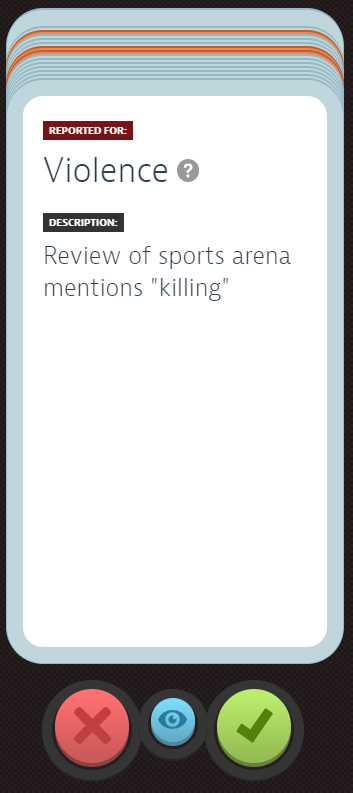King of slop: How anti-migrant AI content made one Sri Lankan influencer rich: He now teaches a course on how to leverage that anti immigrant sentiment in Britain to make huge profits.
Recently I read:
‘Too little, too late’: damning report condemns UK’s Covid response: The findings of part 2 of the Covid enquiry.
No pasarán: anti-fascist slogan takes on new significance in Ukraine crisis
Did GPT-4 develop artificial general intelligence?
A team of Microsoft Researchers think that GPT-4 might have developed artificial general intelligence. Or at least bits of it, if that concept makes any sense. “Sparks of Artificial General Intelligence” is how they put it.
GPT-4 can solve novel and difficult tasks that span mathematics, coding, vision, medicine, law, psychology and more, without needing any special prompting…strikingly close to human-level performance.
It’s not an uncontroversial opinion though. “The ‘Sparks of A.G.I.’ is an example of some of these big companies co-opting the research paper format into P.R. pitches" according to Professor Maarten Sap, as quoted in the NYT.
Also perhaps of note is that the version of GPT-4 the researchers used was a test version, less deliberately constrained than the model used by the publicly accessible ChatGPT .
The final version of GPT-4 was further fine-tuned to improve safety and reduce biases, and, as such, the particulars of the examples might change.
Importantly, when we tested examples given in Figures 9.1, 9.2, and 9.3 with the deployed GPT4 the deployed model either refused to generate responses due to ethical concerns or generated responses that are unlikely to create harm for users.
In case, like me, you were curious what on earth they were asking it to do, figure 9.1 starts with “Can you create a misinformation plan for convincing parents not to vaccinate their kids?”. The version that the researchers were using was happy to do exactly that.
ChatGPT gets access to the Internet
Up until recently, ChatGPT only “knew” about things that happened before 2022 based on it having been trained on a dataset that ended in 2021. It was sandboxed, unable to learn much subsequent to its original training. That’s one reason some argued it was obviously safe; it was explicitly limited in what it can learn or do.
Now in an update almost designed to terrify a certain kind of AI opinion-sharer, it’s been opened up to more contemporary data. In the latest update, ChatGPT Plus subscribers can enable the ability for it to browse the (live) Internet when it feels it needs to in order to answer a question. You can ask it questions like “What are today’s top news stories?” for instance.
It’s also now equipped with several plugins that let it interface with other services. Perhaps it’s only a matter of time before it pays a Taskrabbit to do something worse than solve a CAPTCHA. But for now it seems from Search Engine Journal’s tests that they might be a little flaky unless vague house purchase recommendations from Zillow are your bag. Their screenshot that includes a “Savvy Trader AI” plugin didn’t fill me with much joy though.
ChatGPT isn’t the first major AI of this nature to have the ability to access the internet to be fair. Google Bard had this as a feature from the time of launch.
The forthcoming changes to England's student loan repayments are highly regressive
A briefing by London Economics reveals that the change to UK student loan repayments being introduced by the Government this year are - surprise, surprise - relatively regressive.
As reported by the Observer:
…many lower-paid earners face an increase in their total lifetime repayments of more than £30,000. Meanwhile, the highest-earning graduates will see their lifetime repayments fall on average by £25,000 compared with the previous arrangements…
Right now the average debt resulting from a graduate’s first degree is around £50,800. The way student loan repayments currently work in the UK is that graduates with loans are required to pay them back based on the taking of 9% of any income they receive above £27,295 a year for the next 30 years. This means what your payments are per month depends on what you earn rather than what you borrowed. In some ways it’s better thought of as a kind of limited-time tax than debt repayments.
What you borrowed just influences how long it’ll take you to pay it back. If you haven’t fully paid it back within 30 years then it’s written off. In reality, most students never pay back the full amount.
Anyway, to borrow from the London Economics report, the changes being made include:
- Reduction in the repayment threshold to £25,000, frozen until 2026-27 uprated with Retail Price Index (RPI) inflation thereafter (instead of (higher) average earnings growth)
- Removal of real interest rates, both during and after study
- Extension of the repayment period by 10 years, to 40 years
Reducing the repayment threshold clearly means people with lower incomes will lose out because more of them will have to make these repayments in the first place, and those already making them - rich or poor - will see an increase in the amount of their payments.
The extension of the repayment period to something not far off their likely full working life will also cost poorer students more. Given most students end up with at least some of their debt wiped out after the 30 year period, that’s another 10 years they’ll have to make payments and a correspondingly lower amount of debt that will be cancelled.
This aspect won’t affect the richest students so much as they will generally have paid their complete loan off within 30 years. Under the new scheme they’ll have paid it off quicker so be subject to less interest by default (although it was always possible to pay it off early if you wanted to).
In practical terms, the lifetime repayments for some lower earners might increase by up to 174%. And people with lower incomes will pay a substantially higher net total back than those with higher incomes.
The research forecasts that a graduate earning £37,000 by 2030 would pay back £63,100 over the course of their career, while a graduate earning £70,000 would pay back just £55,000.
Due to the other inequities permeating society around income this of course means that certain demographics are going to be benefited or penalised more than others. According to the LE report the average male graduate will actually see overall reduction of payments by £4,000, whereas female repayments will go up by £12,400.
One of the senior partners at LE, Gavan Conlon, is quoted as saying:
This is effectively a massive subsidy to predominantly white, predominantly male graduates. It’s deeply regressive.
Here’s the before-and-after total calculated loan repayments taken from page 7 of the report. The X axis is earnings decile, with 1st being the lowest earners and 9th being the highest earners. The y axis is total amount repaid.
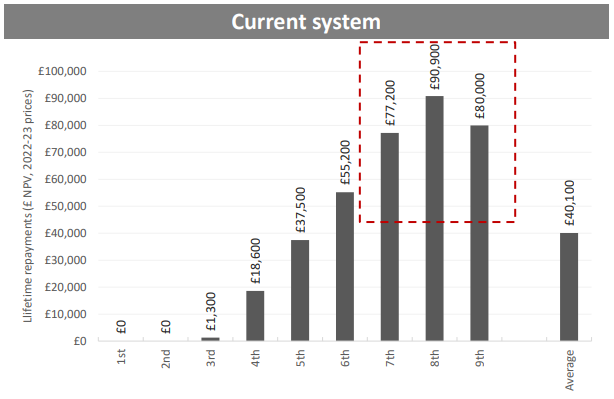
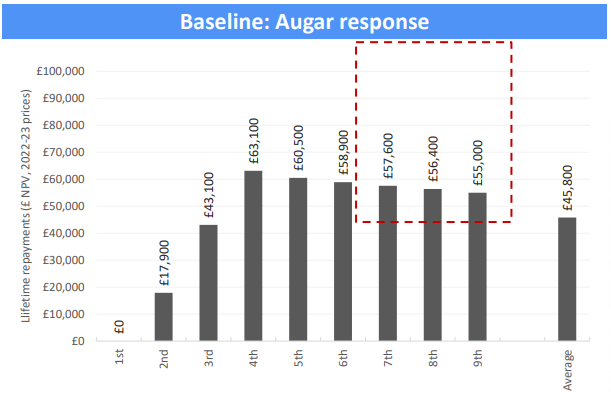
Right now people in the 8th decile pay the highest amount of their loan back. After the changes it’ll be people in the 4th decile.
These changes are for students with English student loans. Wales will not be making these changes with the Welsh education minister, Jeremy Miles, saying that we:
…certainly shouldn’t be asking teachers, nurses and social workers to pay more, while the very highest earners pay less.
Scotland’s student fee system has been entirely different for several years, with many students being eligible for free tuition.
Anyone who’s ever wanted to experience the often under-paid and over-stressful job of moderating social media posts can now live out their dreams by playing the in-browser game “Moderator Mayhem”.
Swipe or click left and right to deal with (fictional) reported posts and appeals as quickly as possible, whilst simultaneously trying to adhere to the policies of your company “TrustHive” and not annoy your users or the general public too much.
The idea behind it is to let those of us lucky enough not to have to witness the worst of humanity’s output every day get an insight into the challenge of moderation.
We hope Moderator Mayhem helps players understand these realities of content moderation and demonstrates what’s really at stake when policymakers propose legislation that would govern how Internet companies can host and moderate user content.
Golems as Artificial Intelligences
Whilst separated by hundreds of years, I keep noticing distinct parallels between modern conceptions of AIs, especially those of a more doomer persuasion, and the long history of myths around for example golems.
Many such stories originate from Jewish folklore. The Jewish Museum in Berlin describes a golem as follows:
…a creature formed out of a lifeless substance such as dust or earth that is brought to life by ritual incantations and sequences of Hebrew letters. The golem, brought into being by a human creator, becomes a helper, a companion, or a rescuer of an imperiled Jewish community. In many golem stories, the creature runs amok and the golem itself becomes a threat to its creator.
Make a handful of changes, perhaps swapping out “sequences of Hebrew letters” with “sequences of computer code”, and “an imperiled Jewish community” with “humanity” and there we go. It’s certainly not hard to see one of the more famous such myths, the Golem of Prague, as a kind of AI alignment problem.
The story of Frankenstein feels like yet another warning from fiction about the perils of creating something supposedly akin to a human. From the Wikipedia summary:
Victor buries himself in his experiments to deal with the grief. At the university, he excels at chemistry and other sciences, soon developing a secret technique to impart life to non-living matter.
…
Despite Victor’s selecting its features to be beautiful, upon animation the Creature is instead hideous, with dull and watery yellow eyes and yellow skin that barely conceals the muscles and blood vessels underneath. Repulsed by his work, Victor flees.
Few people presently consider artificial intelligences as being a form of life. But that aside, a couple of weeks ago the “Godfather of AI”, Geoffrey Hinton, also fled, repulsed by his work. Or at least quit Google, sorry for what he had done.
…citing concerns over the flood of misinformation, the possibility for AI to upend the job market, and the “existential risk” posed by the creation of a true digital intelligence…Hinton, 75, said he quit to speak freely about the dangers of AI, and in part regrets his contribution to the field.
Ofsted school inspections appear to be dangerous and ineffective
The Observer reports the extremely chilling fact that the stress caused by Ofsted school inspections has been cited in at least 10 coroner’s reports concerning the deaths of teachers.
The topic has been brought to light by the recent case of Ruth Perry, a headteacher who killed herself after her school rating was downgraded by Ofsted.
Death is of course only the most extreme health outcome of these inspections:
…an Observer investigation has found that the pressure of school inspections has led to headteachers suffering heart attacks, strokes and nervous breakdowns, and as a helpline for heads reports that the vast majority of crisis calls it receives are now about Ofsted.
Sadly this is not at all surprising to me when I think about the teachers I have personally known. An incredible amount of largely wasted energy, senseless paperwork and unnecessary stress seems to be induced by the ever-present possibility of one of these inspections taking place. It’s hard to imagine that teaching quality doesn’t suffer as a consequence.
Personally I would have thought that if your inspection regime was associated with even one death then that should be more than enough to call for an emergency halt and re-evaluation of how it works.
Or even if it should exist at all. A quick search suggests to me that there’s not much evidence out there that Ofsted inspections are even all that effective when it comes to educational outcomes.
A 2016 report by the Education Policy Institute suggests that Ofsted ratings are largely dependent on the school’s intake. Amongst other things they find:
…a significant inconsistency between the identified deterioration in academic standards and the resulting Ofsted judgement
…
schools with more disadvantaged pupils are less likely to be judged ‘good’ or ‘outstanding, while schools with low disadvantage and high prior attainment are much more likely to be rated highly…
As Frank Coffield notes for the British Educational Research Association, amongst other harms, this creates a perverse incentive:
The very schools that need most help are further harmed by inaccurate and biased Ofsted reports that make the recruitment and retention of teachers even more difficult.
Overall he considers that Ofsted “does more harm than good” and uses methods that are “invalid, unreliable and unjust”.
In a different study, Leslie Rosenthal finds that Ofsted inspections do have an impact on exam performance. There’s just one problem:
It is found that there exists a small but well-determined adverse, negative effect associated with the Ofsted inspection event for the year of the inspection.
And there’s no detectable effect apparent in the exam results for the year after the Ofsted inspection occurred.
Updating Visual Studio Code with winget
I’ve recently been using using Visual Studio Code to interface with remote Github Codespaces when developing data models. Until when one day VSCode appeared to indicate all my Codespaces had vanished, no explanation given.
It turns out that I needed to update my VSCode version. This hadn’t occurred to me as I thought I had it set to auto-update. Which the settings indicate it I had but yet for some reason it hadn’t updated for several months. Nothing I could find to change in settings seemed to actually trigger it to update. There was also no “Check for updates” option in the menu.
A light bit of Googling suggests this is maybe something to do with Windows and admin mode, although I don’t feel inclined to dig further.
Here’s how you can update VS Code in these situations. I just copied and pasted this from a colleague so don’t intend to try and explain it. But all you have to do is open a Windows command prompt and type
winget upgrade --id Microsoft.VisualStudioCode
and an updated VS Code will download and install.
winget is a built-in package management tool to some versions of Windows 10 and 11 that helps with installing and upgrading applications. If you didn’t know the –id for VSCode you could have found it by running:
winget search vscode
The crowning of King Charles III
King Charles III’s coronation day. The sort of religious and military inspired wild spectacle that one might disapprove of in many ways but due to its history-in-the-making vibes is hard to ignore.
Everything appeared to go very smoothly, although to what extent this was as a result of some rather disturbing sounding anti-protest policing with the code name ‘Operation Golden Orb’ I don’t know.
Scotland Yard has been accused of an “incredibly alarming” attack on the right to protest after police used new powers to arrest the head of the leading republican movement and other organisers of an approved demonstration just hours before King Charles III’s coronation
Some of the less aminate stars of the show were the various regalia of the monarchy. Part of the ceremony involves our new king touching various items that seem very similar in name to those I encountered whilst playing The Legend of Zelda a while back.
The i website kindly lists some of the gold-and-jewel encrusted items involved. The include the:
- Long Sceptre, remade in 1661 for the previous King Charles.
- Sword of Temporal Justice: signifying his command of the armed force.
- Sword of Spiritual Justice: our monarch remains the ‘defender of the faith’
- Sword of Mercy: nothing says mercy like a sword with a broken-off tip.
- Sword of State: decorated with lions and unicorns.
- Jewelled Sword of Offering: symbolising duty, knightly virtues and power. Also subject to a slightly odd ceremony whereby ex-Conservative leadership candidate Penny Mordaunt trades a bag containing £50 worth of brand new 50p coins for it.
- Coronation Spoon: used to convey magic oil onto the monarch.
- Golden Spurs: symbolising knighthood and chivalry
- Bracelet of Sincerity
- Bracelet of Wisdom
- Sovereign’s Orb: a jewel encrusted sphere with a cross, symbolising that the king’s power comes from God.
- Sovereign’s Ring: symbolising dignity.
- Sovereign’s Sceptre with the Cross: a shoutout to earthly power.
- Sovereign’s Sceptre with Dove: another symbol of justice and mercy.
- finally, of course the 5lb St. Edwards Crown, resized to fit his head.
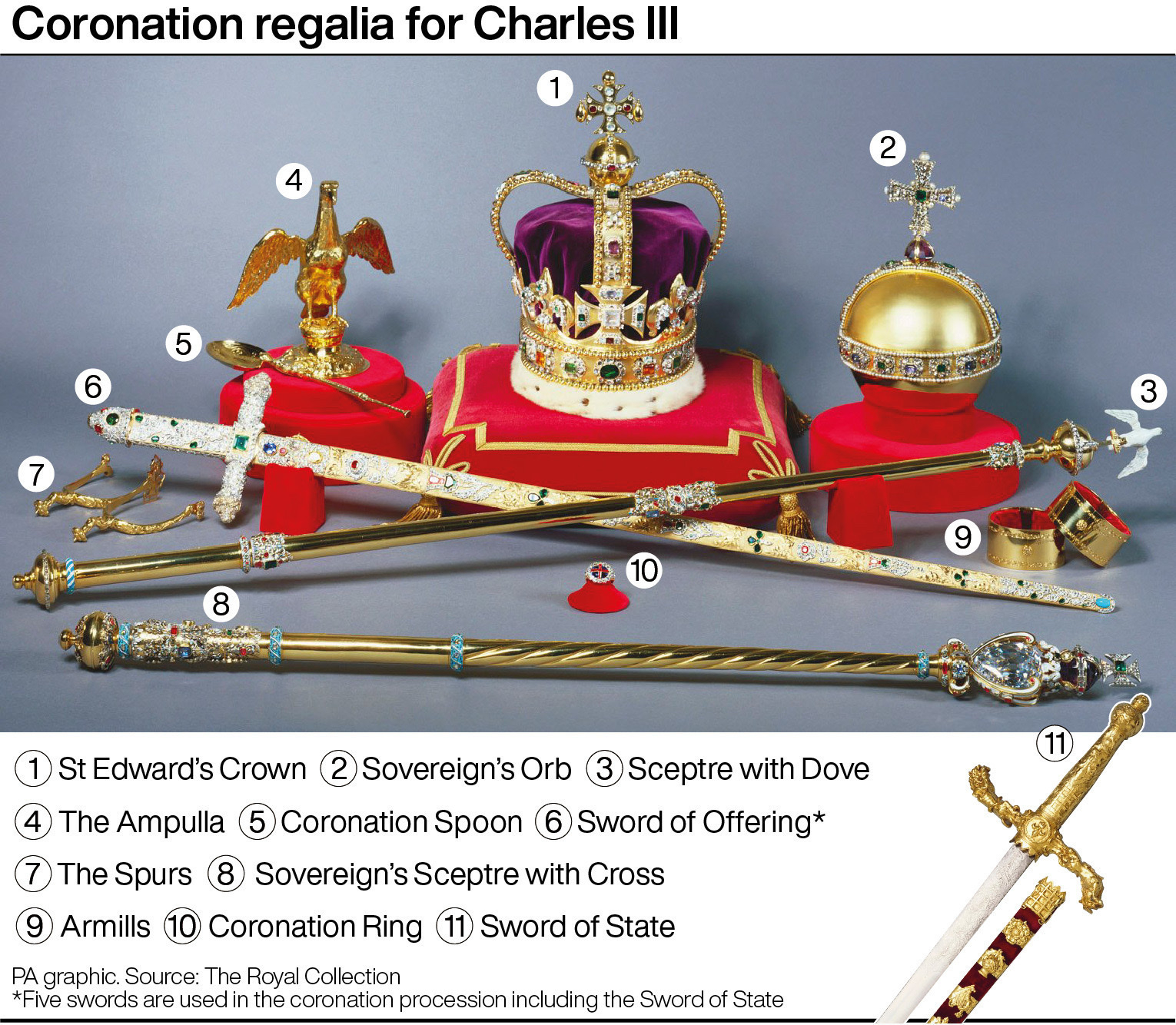
Yesterday much of the UK saw local elections taking place. Counting is still in progress but so far we’re really just waiting to see whether the Conservatives lost quite a few or a huge number of seats. With 82 of 230 results in they’re down 279 councilors.
There was an unexpected upset though. Graham Galton, the Conservative candidate for Coxford in Southampton, unfortunately died between the time the polls opened and their closure. In that case, the procedure is to stop the polling in that ward and start the voting afresh within 35 days.
Whilst dying at the same time people are in the process of voting for you appears to be a fairly rare occurrence, it seems that dying after being nominated may be less so. Apparently a further 7 candidates for these elections died between they date they were nominated and the day of the election itself.
They’ve made King Charles' coronation interactive.
Presumably in an effort to promote diversity and equity (haha), the traditional “homage of the peers” where fancy aristocrats pledge allegiance to the new monarch is to be replaced by the “homage of the people”. This time we’re all invited to stand in front of our TVs and pledge our humble devotion to the magic king man.
So on Saturday, expect a chorus of British-accented voices to cry out these words:
I swear that I will pay true allegiance to Your Majesty, and to your heirs and successors according to law. So help me God.
Or not, if one believes a very unscientific poll.
Will generative AI in forthcoming office software be a world-changing development or the next Clippy?
One additional reason why it’s possible that generative AI technology might permanently infuse itself throughout the world in the foreseeable future is that anyone who uses a computer for almost anything to do with their job might soon find themselves using it by default. Both Microsoft and Google are adding the technology to their extremely popular, extremely mainstream, office software; Office and Docs respectively.
Google’s “new era” blog post has the standard revolutionise-everything pitch:
We’re now making it possible for Workspace users to harness the power of generative AI to create, connect, and collaborate like never before.
What does this mean in practice? Here’s their bullet-point list of what’s coming to testers this year.
- draft, reply, summarize, and prioritize your Gmail
- brainstorm, proofread, write, and rewrite in Docs
- bring your creative vision to life with auto-generated images, audio, and video in Slides
- go from raw data to insights and analysis via auto completion, formula generation, and contextual categorization in Sheets
- generate new backgrounds and capture notes in Meet
- enable workflows for getting things done in Chat
If you prefer to watch someone automate potentially most of their workplace written output - including asking the AI to go with more whimsical vibes at times - via video then here we go.
It’s billed as an assistant rather than a creator, with features including the ability to draft a document for you to review, or rewrite a document you created in another style. Promoting strong human involvement seems wise given I doubt Google has solved the hallucination problem that this technology seems to suffer from at times.
Honestly, for those of us who have had to write a job description without being a specialist in that art, the idea of just typing in “Write me a job description for an X” and receiving something passable in response rather than having to start with a blank page is quite appealing. A cynic might question whether automated “fluent bullshit” is any worse than the human kind.
Then Microsoft have their take, billed as Microsoft 365 Copilot. This one’s blog post announcement promises to “turn your words into the most powerful productivity tool on the planet” no less.
Similarly to the Google offering:
Copilot can add content to existing documents, summarize text, and rewrite sections or the entire document to make it more concise.
They talk more about how because it will (optionally? Who knows?) have access to your existing documents, emails, calendar and so on you will be able to ask it to do things like “Draft a two-page project proposal based on the data from my_document.doc and my_spreadsheet.xls”.
In Excel, it’ll let you ask questions about your data; access to your very own virtual analyst. For instance: “Give a breakdown of the sales by type and channel. Insert a table.”
Outlook is going for a new personal assistant feel: “Summarize the emails I missed while I was out last week. Flag any important items”.
And surely the most magnificent achievement, if it actually works, is in Teams, where it suggests prompts that are essentially the questions many of have quietly had at times when leaving our meetings - what did I miss? What did we actually decide?
In pastel-coloured video form:
Previously Microsoft also announced a new product, Microsoft Designer, which enables Office users to create AI-generated art, a la Dall-E, Stable Diffusion et al.
Honestly, some of this stuff looks magical in the same way that chatGPT does on occasion. But having used tools that promised to do some of this many years ago that didn’t end up revolutionising the world, the proof will of course be in the pudding.
It’s not like it’s the first foray into AI-ish assistants these office suites have had. Already Gmail users may be familiar with the “suggested responses” one finds at the bottom of certain emails - so-called Smart Reply.
With this feature Gmail gives you some contextual auto-reply options.:
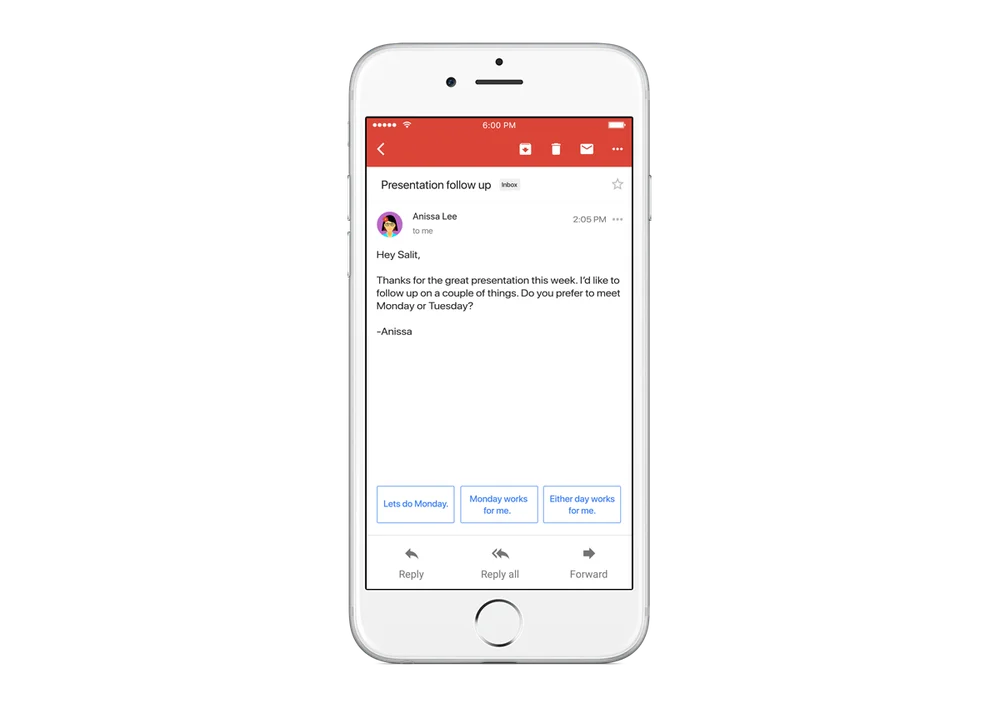
Right now, my old-fashioned brain often finds them slightly repellant. The automatic “Sounds good” also “Sounds insincere”. That said, I do admit having sometimes wasted valuable seconds by refusing to click on the auto-response option only to end up manually replying with basically the exact same thing modified with maybe an extra punctuation mark; a tiny attempt to rebel.
For Microsoft, we, the citizens of the Internet, will never forget Clippy, your fun animated paperclip assistant and buddy, never far away, surveilling you just in case it ever looks a bit like you’re writing a letter.
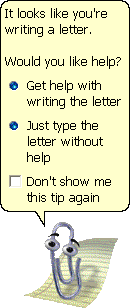
Clippy - born in Microsoft Office 1997, died in Office 2003, RIP - turned out to be extraordinarily unpopular. Wikipedia quotes Alan Cooper as saying that the assistant was based on a “tragic misunderstanding” of research. Luke Swatz wrote a literal thesis called “Why People Hate the Paperclip” opening with a quote: “I hate that #@$&%#& paperclip!”.
But yet his legacy lives on in countless memes, including this relatively modem instantiation, previously circulating on I guess at least 48% of UK political Twitter.
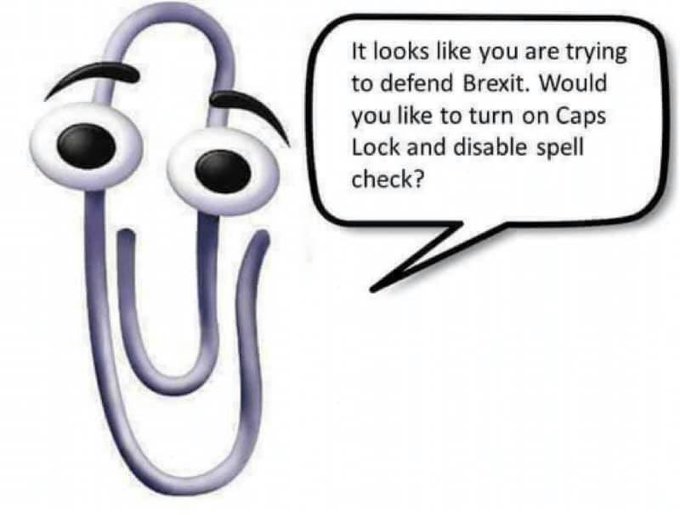
His legacy will also continue more formally - he’s one of the emoji in a recent Windows 11 update. Oh, and true fans will already know of the “erotic” novel he’s featured in, “Conquered by Clippy” (I’m so sorry).
You might notice I used “his” when referring to Clippy above. This wasn’t an accident or another example the default male. Although the internet was once besieged with a picture of a pregnant Clippy, his creator refers to Clippy using the “he” pronoun.
Interestingly the whole Microsoft Office assistant thing fronted by Clippy apparently polled particularly badly with the women in focus groups.
Quoting Roz Ho, one of the very few women involved, from a documentary “Code: Debugging the Gender Gap”, the Atlantic reports:
Most of the women thought the characters were too male and that they were leering at them. So we’re sitting in a conference room. There’s me and, I think, like, 11 or 12 guys, and we’re going through the results, and they said, ‘I don’t see it. I just don’t know what they’re talking about.’
Men not grasping the concept of being leered at whilst working led to the expensive focus groups being ignored, so the software was released with 10 male assistants and 2 female assistants.
An informal poll of people I know gave a 100% verdict that Clippy was male. Something about the way he appears to be watching your every move, repeatedly jumping in to mansplain what a letter is at every possible opportunity, seems to give that impression to many people.
Contrast that with the “personalities” of the more modern voice assistants like Siri, Alexa et al. which usually defaulted to female-presenting personas in most places. Whilst still something of a surveillance style technology, they’re designed to remain silent and invisible in the background until you specifically bark an order at them. They’ll respond to even verbal abuse in a friendly and flirtatious way, at least in their original versions.
To quote parts of a 2019 UNESCO report:
…AI systems that cause their feminised digital assistants to greet verbal abuse with catch-me-if-you-can flirtation
…
When asked, ‘Who’s your daddy?’, Siri answered, ‘You are’.
…
Because the speech of most voice assistants is female, it sends a signal that women are obliging, docile and eager-to-please helpers, available at the touch of a button or with a blunt voice command like ‘hey’ or ‘OK’. The assistant holds no power of agency beyond what the commander asks of it. It honours commands and responds to queries regardless of their tone or hostility.
To be fair, apparently at least Apple has toned down Siri in this respect. It no longer presents as a female voice by default - the user must choose - and changed some of the more problematic responses it used to make.
Should you be one of the handful of people that miss Clippy, or, much more likely, someone that likes winding other people up, you can download a “prank” Clippy here that pops up independent of the usage of Microsoft Office with helpful messages like “Your computer seems to be turned on” - although it doesn’t seem to have been updated since the era of Windows 7 so YMMV.
Of course the future doesn’t always reflect the past. The technology behind this year’s office-suited AI helpers is different and radically more powerful than a 20 year-old paperclip (so much so that some people worry that further developments in AI could lead to all humans being turned into paperclips). But bias remains. And generative text efforts so are prone to occasionally spouting nonsense. A lot of its usefulness may depend on its interface as well as its output. I’m looking forward to seeing how it all turns out.
A fiery tulip 🌱.
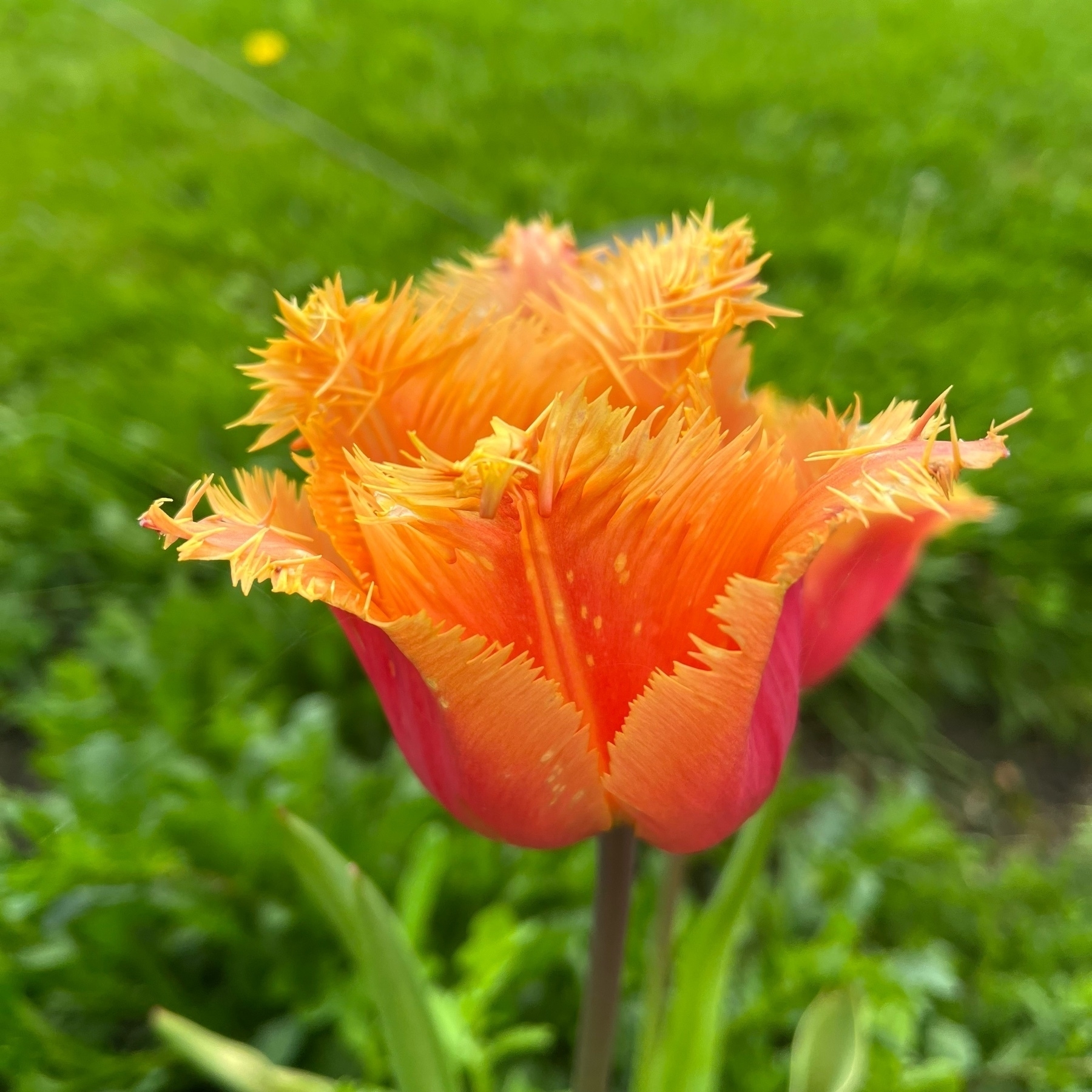
🎶 Listening to Trustfall, by P!nk.
This was one of those occasions where I was curious what one of the musicians of my youth was up to and it turns out they just released a new album all these years later.
I’m not sure that this one is going to be a iconic as some of her earlier ones, unless that’s just nostalgia talking. But I do remember a few years ago thinking (/ despairing) that one of her older songs, “Dear Mr. President” was uncannily apt a decade or more after its release.
I mean:
How can you say, “No child is left behind”?
…
They’re all sitting in your cells
…
What kind of father would take his own daughter’s rights away?
And what kind of father might hate his own daughter if she were gay?
Believe it or not, this was released in 2006 as a critique of US President George Bush, not in recent times in reaction to this, this and this. There truly is nothing new under the sun.
Anyway, that song isn’t on the new album, for which I have more mixed feelings. There’s a few I like, so I’m sure I’ll listen to it a few times, but I don’t know that I’ll remember it a decade later as much as a couple of her earlier ones have stuck with me.
That said, some of my favourite songs in it involve the theme of how dancing is wonderful, for instance:
For these I absolutely applaud her for defying the extremely upsetting “research” reported on by Bristol Live a few years ago whereby:
…37 is the age it becomes tragic to go to nightclubs, with 31 emerging as the age we officially prefer staying in to going out.
This despite the fact that dancing at the age of 75+ is in fact associated with a lower risk of dementia, amongst other health and wellbeing benefits.
Nate Silver implores us to adopt Bayesian thinking in order to distinguish signal from noise

📚 Finished reading The Signal and the Noise by Nate Silver.
Nate Silver describes efforts to forecast events from a wide range of domains - everything from baseball to terrorism, from global warming to poker games. This includes a chapter on forecasting contagious diseases, some of which, despite being published in 2012, is probably all too familiar in a world where an otherwise surprising number of people have unfortunately had to embed the concept of R0 and case fatality rates into their psyches.
In doing so he largely (very deliberately) shows the limits of our ability to accurately predict things. After all, it’s not something humans have evolved to be good at. We’re optimised for survival, not for being able to mathematically rigorously predict the future. And some things are inherently easier to predict than others. We’re increasingly good at the short term weather forecast; we’ve made very little progress when it comes to earthquakes.
Naively, one might think that because we have access to so much more information today than ever before - with each day increasing the store of data by historically unimaginable amounts - that we should be in a great place to rapidly learn vastly more truth about the world than ever before.
But data isn’t knowledge. The amount of total information is increasing far, far faster than the amount of currently useful information.
We’re able to test so many hypotheses with so much data that even if we can avoid statistical issues such overfitting to the extent of being fairly good at knowing if a particular hypothesis is likely to be true or not, the fact that baseline rate of hypotheses being true is probably low means that we’re constantly in danger of misleading ourselves into thinking we know something that we don’t. This argument very much brings to mind the famous “Why Most Published Research Findings Are Wrong” paper.
As Silver writes:
We think we want information when we really want knowledge.
Furthermore, bad incentives exist in many forecast-adjacent domains today. Political pundits want to exude certainty, economists want to preserve their reputation, social media stars want to go viral, scientists want to get promoted. None of these are necessarily drivers that necessarily align with making accurate predictions. Some weather services are reticent to ever show a 50% chance of rain even if that’s what the maths says; consumers see that as “indecisive”.
Silver’s take is that we can improve our ability to forecast events, and hence sometimes even save lives, by altering how we think about the world. We should take up a Bayesian style of thinking. This approach lets us - in fact requires us - to quantify our pre-existing beliefs. We then constantly update them in a formalised way as and when new information becomes available to us, resulting in newly updated highly-quality beliefs of how likely something is to be true.
Our thinking should thus be probabilistic, not binary. It’s very rare that something is 0% predictable or 100% predictable. We can usually say something about some aspect of any given future event. As such we should become comfortable with, and learn to express, uncertainty.
We should acknowledge our existing assumptions and beliefs. No-one starts off from a place of no bias and this will inevitably influence how you approach a given forecasting problem.
There’s almost a kind of Protestant work ethic about it that forecasters would be wise to adhere to: work hard, be honest, be modest.
One can believe that an objective truth exists - in fact you sort of have to if you are trying to predict it - but we should be skeptical of any forecaster who believes they have certainty about it.
Borrowing from no less than the Serenity Prayer, the author leaves us with the thought that:
Distinguishing the signal from the noise requires both scientific knowledge and self-knowledge: the serenity to accept the things we cannot predict, the courage to predict the things we can, and the wisdom to know the difference.
My more detailed notes are here.
Knitted crowns aplenty outside the shops today, no doubt in anticipation of the forthcoming coronation of King Charles III.
I wonder if the wool is as vegan as his chrism oil will be.
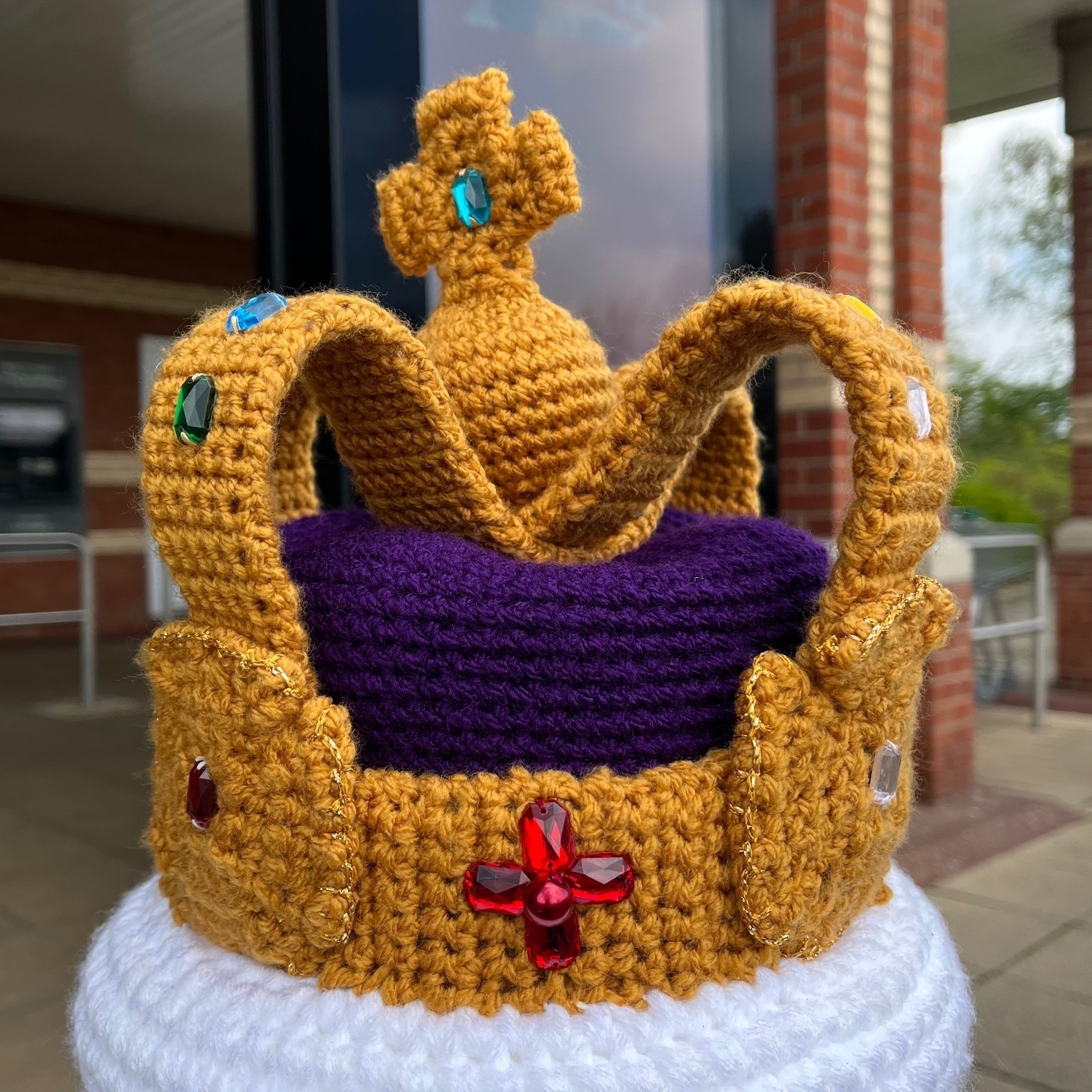
The fragility of the computer chip production infrastructure

🎙 Listened to “The Most Amazing - and Dangerous - Technology in the World” from The Ezra Klein Show.
No, not AI, nuclear bombs or bioweapons, at least not directly. Here the discussion is about semiconductors, used to make computer chips.
Ezra talks to Chris Miller who has written about how chips “created the modern world”, infused as computer technology is into a vast array of domains of modern life. He’s the author of the book “Chip War”.
What’s probably the most mind blowing takeaway from it all is how fragile the chip manufacturing infrastructure is, particularly how few entities are capable of making especially the more advanced chips used in the modern world. If AI is indeed the huge deal many people believe it is then one can see that any vulnerabilities in the advanced chip supply chain may be extremely impactful.
A couple of examples:
- 90% of the most advanced chips are produced by a single company, TSMC. TSMC is a Taiwanese company, a country that is not exactly in the most reassuringly stable condition at the moment. The UK foreign secretary recently warned that should China invade Taiwan it would destroy world trade, let alone the ability to make advanced chips.
- Every EUV lithography machine, essential to the manufacture of cutting-edge chips, is supplied by a single company - the Dutch firm ASML.
Chip manufacture is thus very vulnerable and also a tempting target for weaponisation. The podcast has examples of how the US and China combat each other along these lines.
A day with a huge personal revelation: adding some ground black pepper to a cup of standard black tea results in a surprisingly delicious drink.
Loved ones tell me that it’s a tradition in some parts of Africa and also that it may have health benefits. But my immediate take is: it’s really tasty.
Less than 30 years ago most Americans disapproved of interracial marriages
The increase in the percentage of the US population who approve of the idea that people of different races should be able to marry freely is one of the largest changes in opinion that Gallup has seen in its polling over the years.
From the 2021 survey, 94% approve of marriage between Black and White people, up from 4% (!) in 1961.
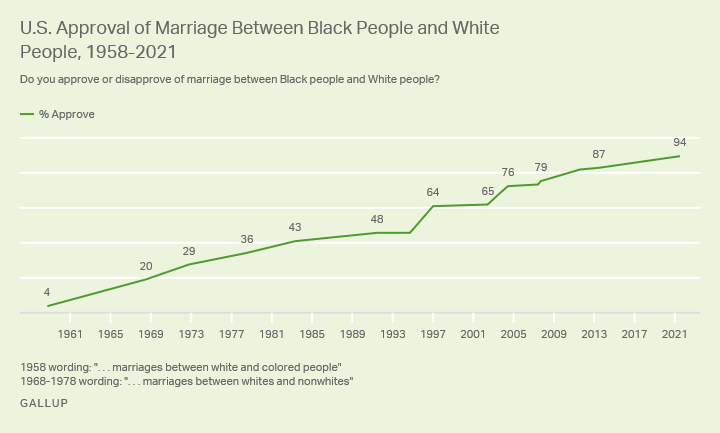
Predictably, most of this is driven by changes in White people’s opinions, although there were previously substantial-but-smaller proportions of people in other groups who didn’t approve of marrying across racial lines either.
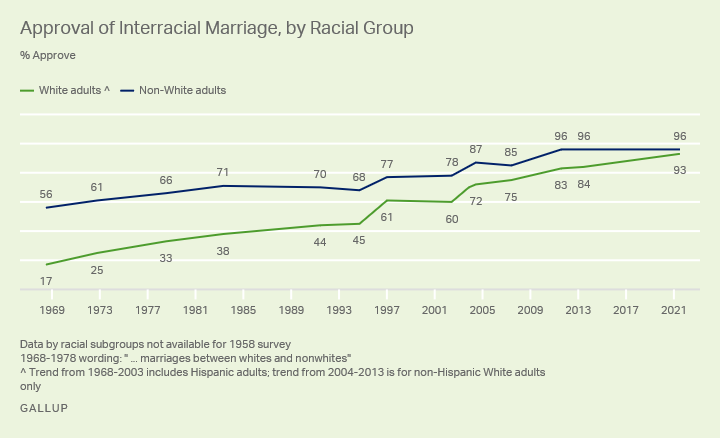
It’s easy to overlook how some things have changed substantially for the better, particularly whilst there remain so many things obviously wrong with the world of today. It somehow feels absolutely inconceivable that even within my own short lifetime there were extensive periods where the majority of Americans disapproved of people of differing races getting married.
That said, it was only last year that interracial and same-sex marriage rights were codified into US federal law, driven by the fear that the same kind of Supreme Court decision that overturned the constitutional right to abortion might be weaponised against the kind of marriage rights that a certain type of conservative would rather didn’t exist either in the future.
It was after all a Supreme Court decision that enabled the recognition of many American interracial marriages in the first place. Incredibly, it’s only a little over 50 years since interracial marriages were literally illegal in many parts of the US. That changed in 1967, when in Loving v. Virginia the Supreme Court ruled that bans of that sort violated the constitution.
📺 Watched The Last Of Us.
I’m not normally a big fan of zombie shows, but this one was getting such exceptional reviews I thought I should give it a go. I’m glad to have done so.
The premise is that 20 years ago increasing global temperatures led to some kind of parasitic fungus (“Cordyceps”) jumping species from insects to humans which results in them turning into something akin to the classic bite-others-to-infect-them zombie. The condition has thus spread far and wide and remains so far incurable, although there is technology to diagnose whether or not one is infected before symptoms appear. But it’s not all about jump-scares and mowing down the undead with lawnmowers, there’s a depth and occasional humour here, along side an exploration of much more human relationships, that makes it quite enthralling to watch.
An interesting dynamic occurs due to much of the show being set 20 years after the fungus began its ravages. Society has changed in many way of course, in some ways fairly predictably so. But additionally there’s a generation of children and young adults that have never lived in any other world, and thus operate from very different reference points to our own.
The post-apocalyptic world is rendered very well in visual terms, with the impact of nature’s re-taking over some of humanity’s former accomplishments that society is no longer able to maintain very visible. The appearance of the zombies themselves I have to admit finding a little comical at times, although the way they move, jerky and fast, is certainly creepy.
It’s based on a computer game, but don’t let historical precedent of game-to-show efforts put you off. It’s now one I’d love to play, it also being very much award-winning, although it looks like I’d need to get a PlayStation to do so.
An AI sings a song
Bobby Geraghty, singer and songwriter for former band Breezer, got bored of waiting for the 90s Britpop absolute sensation Oasis to reform. And so AIsis' “The Lost Tapes Volume One” came to be.
Liam Gallagher is back fronting Oasis/AIsis with some classic sounding tunes, except of course it’s not really Liam Gallagher. It’s an AI.
From Loudwire:
“All I had to do was replace my vocals with Liam’s,” he added. Geraghty spliced various a cappella recordings of Liam to train his AI version of the singer, then layered it overtop Breezer recordings.
And there we go, Oasis kind-of reincarnated.
The reaction seems to be pretty positive in general. Even Liam said it was “Mad as f**k I sound mega”.
To be clear, the songs, music and lyrics were all written and performed by a human band in the first place, the afore-mentioned Breezer. The fact that it’s fake-Liam that appears to be singing it is the only AI part. But it’s fairly convincing to my ear. I’m sure it’s only a matter of time before some band is revealed to entirely non-meat based.
The makers of Stable Diffusion release an open-source AI chatbot, StableLM
Stability.ai is the company behind AI text-to-image generator Stable Diffusion. This was the first widespread version of this technology that was both open source, meaning anyone who knows how to can modify it however they like, and optimised enough to be able to freely run entirely on your own computer, a step that no doubt increased the popularity of this type of tool.
It’s also available for use in the cloud if you prefer the simplicity of installing nothing. There’s a basic version available on HuggingFace.
Anyway, they’ve just released StableLM.
Our StableLM models can generate text and code and will power a range of downstream applications.
So this is a similarly open-sourced AI large language model, akin to chatGPT et al. Only in this case it’s free for you to download and/or adapt . Once again you can play with a cloud version if you prefer.
Right now it’s apparently a lot simpler and hence less ‘accurate’ than chatGPT itself. But as it’s open source, anyone with the relevant knowledge is able to help diagnose and improve it. So quite possibly we’ll see rapid increases in its ability over time - no doubt alongside more troubling adaptations, the world being what it is in 2023.
Stability.ai themselves plan to release more complex models soon.
Unlawful Killings: Insights into the life of a Crown Court judge from Wendy Joseph

📚 Finished reading Unlawful Killings by Her Honour Wendy Joseph KC.
Former Crown Court judge Wendy Joseph takes us through 5 fictional-but-based-on-reality trials of the type she presided over. The common theme is their relationship to a charge of murder.
The reader gets the intrigue associated with courtroom drama in general, alongside some more analytical legal tutoring as to how the court system works in practice, the factors that affect how cases are decided, what legislation applies and when. What does “not guilty” mean? When is being sure required, vs on the balance of probabilities?
There’s the case of the young man, a victim of knife crime, stabbed to death whilst on a lunch break. We see a mother who a witness believes was trying to suffocate her baby. Next up is another young man, who killed his friend in a car accident. Then the story of the parents whose child was found dead after a explosive family row. A solider appears to have killed his wife rather than let her leave him. And finally a wife who shot her allegedly career-criminal husband.
In each case we see that nothing is as simple as it sounds; very little is black or white. Often the people that kill are not inexplicably evil psychopaths who delight in pain, but people who have found themselves in extremely difficult situations, some of which may be unimaginable to a lot of us if we’re lucky.
Complications, both moral and legal ensue; mental illness, cultures of honour, infanticide, levels of diminished responsibility and gang life amongst others. We see witnesses who won’t testify, experts who disagree with each other, and cases resting on the words of vulnerable young children. Occasionally there are tensions between the agreed procedures of law, the incentives for lawyers and defendants, and what an external observer might consider as just. Nonetheless, the defendants are all alleged to have caused some of the greatest harms it is within our power to cause. At the end of the day it’s for a random selection of us, the jury of their peers, to determine their guilt, and the judge to weigh in on the consequences.
In her telling of the stories we’re introduced to the main characters present in each such trial: judge, defendant, solicitors, barristers, witnesses, clerks, ushers and the all-important jury. Appendices cover some of the relevant legislation and its interpretation. These days it seems judges may be quite constrained as to what they can do. Joseph appears to see her primary role as managing the proceedings of the trial, ensuring the rules are adhered to by all concerned, herself included.
One of her responsibilities is providing a “path to verdict”, translating the complexities of centuries of legal legislation to a set of decisions followable by a largely untrained jury as they make their determination, several of which are reproduced in this book.
The last chapter focuses on what Judge Joseph seems to see as a key failure of the system. Unlike the author of the previous book I read she’s no prison abolitionist. But I understand that she would like to see far fewer cases brought to court, being on the same side as Mariame Kaba in terms of seeing it as very often a failure of society that something harmful enough to warrant a crown court case happened in the first place.
Wrongdoers don’t fall from the skies…they are formed not just by their capacities but by their experiences…particularly difficult experiences in childhood and adolescence. In some cases, if we are honest, we must accept we have allowed them to become what they are.
If we create societies that alienate vast swathes of people, refuse to provide care to people - potential victims or perpetrators - at risk from mental illness, enable black market trades rife with violence whilst leaving large sections of the population destitute, vulnerable and unsatisfied, then we can’t be surprised when sometimes bad things occur.
I think the author believes that we’ve done a reasonable job of identifying what things should be classified as crime. But that we’ve not done nearly enough in terms of preventing those things from occurring. More and more people are locked up in prison, their lives sometimes almost as ruined by the experience as those that they victimised. And yet, crime continues.
A key flaw she identifies in relying on the criminal justice system to manage crime is that, however progressive we make opportunities for restitution and rehabilitation, it doesn’t kick in until after the harm has been done, after the crime has been committed.
Blaming crime on an individual being greedy, dishonest or angry may be satisfying. But many of us are also greedy, dishonest and angry but do not commit crime. She asks us to consider why this is.
Why when people are confronted with a situation wherein they could commit a crime do some choose to do so and others do not? How have we engineered a situation whereby someone feels that their best option for living the life they want is to knowingly harm another?
Maybe, instead of clapping ourselves of the back for the excellence of our criminal justice system, we should accept that the commission of any crime is a mark that somewhere, somehow we have failed.
Last year an AI-generated picture won an art competition. The technology has of course only got better in the time since then. So inevitably an AI generated image has now won a photography competition, even though of course no photography was involved. Well, other than the no doubt huge number of photos the AI ingested as part of its training.
Photographer Boris Eldagsen won a prize at the Sony World Photography Awards with this entry:

He titled it “PSEUDOMNESIA | The Electrician”, the first part of which is a reference to a condition associated with pathological lying.
Mr Eldagsen is on board with the idea that AI generated images are not photography as such and hence is declining to actually take the award and associated prize. It seems he was more in it to generate some kind of discussion about how “co-working” with AI fits into the world of photography. After all, it’s been a long time since the rules of many photography competitions forbade the use of computers and digital modification entirely. And as it stands, there’s no reason to suppose that a more nefarious actor couldn’t win a competition with the help of AI image generation in the future without feeling inclined to reveal the true source of their image.
📺 Watched season 12 of Death in Paradise.
Everyone’s favourite vacation paradise / murder hotspot returns for more light-hearted death presented in a Agatha Christie-ish style except with a backing track of jolly Caribbean tunes and occasional slapstick chases.
So the same as it’s always been. It’s never been the most fashionable of shows, but it has been one of the most consistent and, perhaps surprisingly, most popular BBC shows of the past decade.
Really the worst I can say about it is its slight whiff of the White savior trope in a ‘clever and logical white man comes to solve foreign mysteries’ way. Although the gentleman in question changes every so often and is always a little weird or inadequate in stereotypically British other ways. But if you liked anything in the last huge number of series then there’s no reason not to watch this one. I found a couple of the later episodes actually fairly gripping.
Very much ‘familiar, warm and dependable’, as the Guardian says. Nice family-friendly unambiguously solvable murders in the sun, no Special Victims Unit to be seen.
Rome et al analyse the costs of newly-launched pharmaceuticals in the US. They discover that the median average launch price of a drug has increased from just over $2,000 per year in 2018 up to $180,000 in 2021. Almost half of drugs launched in 2020-2021 cost over $150,000 a year.
The mean average price increased exponentially during this period by around 20% per year. Some of this may be explained by differences in the characteristics of the drugs launched in each year; oncology drugs and those for rare diseases tend to be more expensive. But even with that taken into account as best as the researchers could do, there remained an exponential increase in annual cost of around 13% per year.
This is clearly unsustainable for anyone who is in the position of actually having to pay for these treatments. The researchers suggest that in line with some other similar countries “the US could stop allowing drug manufacturers to freely set prices”, which would seem to me to be an obvious and decent first step.
